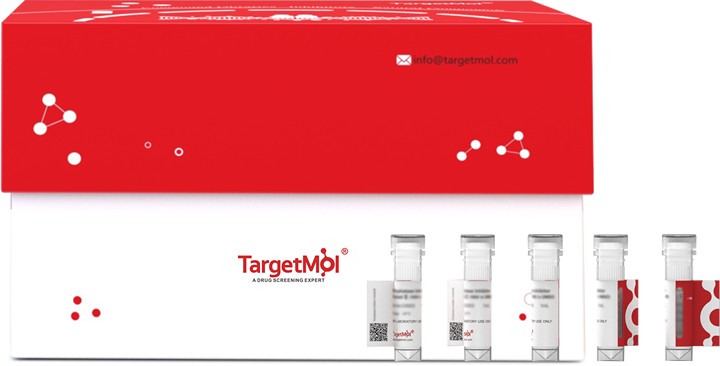购物车
全部删除  您的购物车当前为空
您的购物车当前为空
别名 Voltage-gated potassium channel subunit Kv1.1, Voltage-gated potassium channel HBK1, Voltage-gated K(+) channel HuKI, Potassium voltage-gated channel subfamily A member 1, KCNA1
KCNA1 Protein, Human, Recombinant (His) is expressed in E. coli expression system with N-6xHis tag. The predicted molecular weight is 22.2 kDa and the accession number is Q09470.


为众多的药物研发团队赋能,
让新药发现更简单!
KCNA1 Protein, Human, Recombinant (His) is expressed in E. coli expression system with N-6xHis tag. The predicted molecular weight is 22.2 kDa and the accession number is Q09470.
| 规格 | 价格 | 库存 | 数量 |
|---|---|---|---|
| 5 μg | ¥ 489 | 20日内发货 | |
| 10 μg | ¥ 797 | 20日内发货 | |
| 20 μg | ¥ 1,320 | 20日内发货 | |
| 50 μg | ¥ 1,970 | 20日内发货 | |
| 100 μg | ¥ 2,680 | 20日内发货 | |
| 200 μg | ¥ 4,160 | 20日内发货 | |
| 500 μg | ¥ 7,490 | 20日内发货 | |
| 1 mg | ¥ 11,700 | 20日内发货 |
| 产品描述 | KCNA1 Protein, Human, Recombinant (His) is expressed in E. coli expression system with N-6xHis tag. The predicted molecular weight is 22.2 kDa and the accession number is Q09470. |
| 生物活性 | Activity has not been tested. It is theoretically active, but we cannot guarantee it. If you require protein activity, we recommend choosing the eukaryotic expression version first. |
| 研究背景 | Voltage-gated potassium channel that mediates transmembrane potassium transport in excitable membranes, primarily in the brain and the central nervous system, but also in the kidney. Contributes to the regulation of the membrane potential and nerve signaling, and prevents neuronal hyperexcitability. Forms tetrameric potassium-selective channels through which potassium ions pass in accordance with their electrochemical gradient. The channel alternates between opened and closed conformations in response to the voltage difference across the membrane. Can form functional homotetrameric channels and heterotetrameric channels that contain variable proportions of KCNA1, KCNA2, KCNA4, KCNA5, KCNA6, KCNA7, and possibly other family members as well; channel properties depend on the type of alpha subunits that are part of the channel. Channel properties are modulated by cytoplasmic beta subunits that regulate the subcellular location of the alpha subunits and promote rapid inactivation of delayed rectifier potassium channels. In vivo, membranes probably contain a mixture of heteromeric potassium channel complexes, making it difficult to assign currents observed in intact tissues to any particular potassium channel family member. Homotetrameric KCNA1 forms a delayed-rectifier potassium channel that opens in response to membrane depolarization, followed by slow spontaneous channel closure. In contrast, a heterotetrameric channel formed by KCNA1 and KCNA4 shows rapid inactivation. Regulates neuronal excitability in hippocampus, especially in mossy fibers and medial perforant path axons, preventing neuronal hyperexcitability. Response to toxins that are selective for KCNA1, respectively for KCNA2, suggests that heteromeric potassium channels composed of both KCNA1 and KCNA2 play a role in pacemaking and regulate the output of deep cerebellar nuclear neurons. May function as down-stream effector for G protein-coupled receptors and inhibit GABAergic inputs to basolateral amygdala neurons. May contribute to the regulation of neurotransmitter release, such as gamma-aminobutyric acid (GABA) release. Plays a role in regulating the generation of action potentials and preventing hyperexcitability in myelinated axons of the vagus nerve, and thereby contributes to the regulation of heart contraction. Required for normal neuromuscular responses. Regulates the frequency of neuronal action potential firing in response to mechanical stimuli, and plays a role in the perception of pain caused by mechanical stimuli, but does not play a role in the perception of pain due to heat stimuli. Required for normal responses to auditory stimuli and precise location of sound sources, but not for sound perception. The use of toxins that block specific channels suggest that it contributes to the regulation of the axonal release of the neurotransmitter dopamine. Required for normal postnatal brain development and normal proliferation of neuronal precursor cells in the brain. Plays a role in the reabsorption of Mg(2+) in the distal convoluted tubules in the kidney and in magnesium ion homeostasis, probably via its effect on the membrane potential. |
| 种属 | Human |
| 表达系统 | E. coli |
| 标签 | N-6xHis |
| 蛋白编号 | Q09470 |
| 氨基酸序列 | MTVMSGENVDEASAAPGHPQDGSYPRQADHDDHECCERVVINISGLRFETQLKTLAQFPNTLLGNPKKRMRYFDPLRNEYFFDRNRPSFDAILYYYQSGGRLRRPVNVPLDMFSEEIKFYELGEEAMEKFREDEGFIKEEERPLPEKEYQRQVW |
| 蛋白构建 | 1-154 aa |
| 蛋白纯度 | > 90% as determined by SDS-PAGE. |
| 缓冲液 | Tris-based buffer, 50% glycerol |
| 复溶方法 | A Certificate of Analysis (CoA) containing reconstitution instructions is included with the products. Please refer to the CoA for detailed information. |
| 别名 | Voltage-gated potassium channel subunit Kv1.1, Voltage-gated potassium channel HBK1, Voltage-gated K(+) channel HuKI, Potassium voltage-gated channel subfamily A member 1, KCNA1 |
| 内毒素 | < 1.0 EU/μg of the protein as determined by the LAL method. |
| 分子量 | 22.2 kDa (predicted) |
| 运输方式 | In general, Lyophilized powders are shipping with blue ice. Solutions are shipping with dry ice. |
| 存储 | Lyophilized powders can be stably stored for over 12 months, while liquid products can be stored for 6-12 months at -80°C. For reconstituted protein solutions, the solution can be stored at -20°C to -80°C for at least 3 months. Please avoid multiple freeze-thaw cycles and store products in aliquots. |
对于不同动物的给药剂量换算,您也可以参考 更多